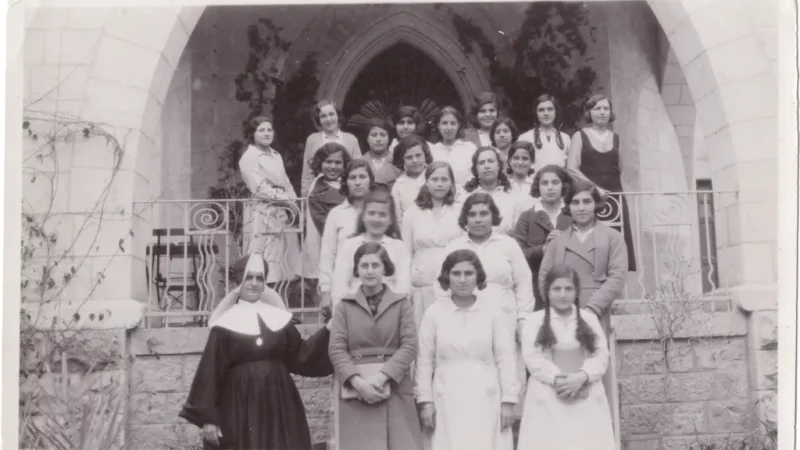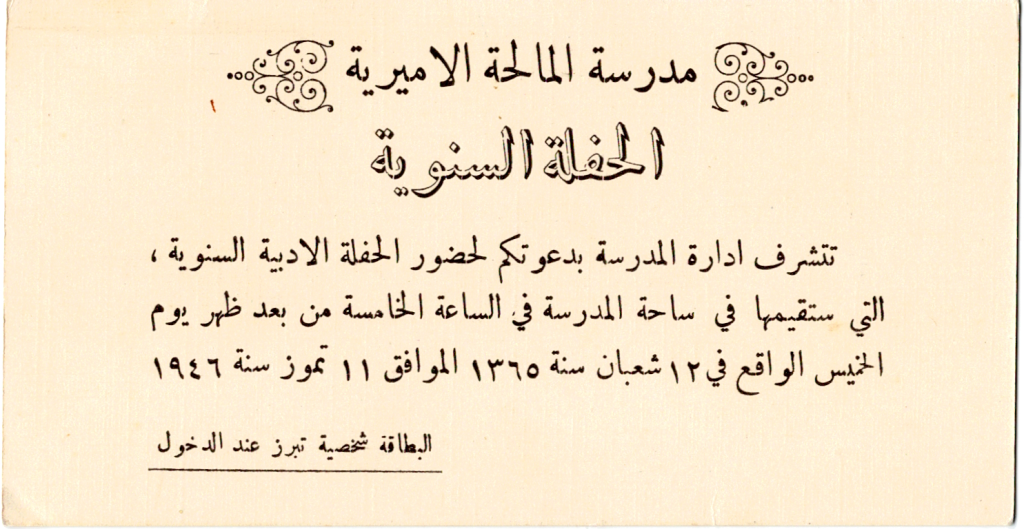
Saniyeh wrote on this photo: At Schmidt College after before the Nakbah, I'm in 7th grade.” Saniyeh Nusseibeh Collection, Khazaen Archive. Used with permission
This story, written by Sarah Dajani, was originally published on January 25, 2023, by Khazaen, an independent organization based in Jerusalem that collaboratively builds an Arabic archive documenting daily Arab life. An edited version is republished here with permission.
Saniyeh Nusseibeh came into this world in March of 1916, just one year before the fall of Ottoman rule in Palestine. Her birthplace was a magnificent house situated at the doorstep of King Faisal Gate, in close proximity to the holy Al-Aqsa Mosque.
Saniyeh was the youngest of seven siblings, including three half-brothers and three full-siblings. Sadly, the family was bereft of their father, Saleh, before she had even reached her second year, leaving her mother to shoulder the responsibility of raising the children alone.
In 1925, Saniyeh embarked on her educational journey at Almamonia school in Jerusalem. Among her meticulously preserved papers, was the curriculum for first and second grades, which encompassed the elegant art of Arabic calligraphy, drawing and painting, handmade crafts, and nature.

Student Saniya Nusseibeh grades, 1928. From the Palestinian Government, Al-Ma’mouniyyah School. Saniyeh Nusseibeh Collection, Khazaen Archive. Used with permission.
She completed her initial educational stages at Almamonia, and later embarked on a new journey at Schmidt College for Girls in western Jerusalem. There, she honed her academic skills and acquired the knowledge necessary to pursue her passion: education.
Saniyeh's archives bear testimony to a plethora of job offers that flooded her way towards the end of the 1930s. She eventually began her career at Almalha school in the early forties, where she soon established herself as one of the first teachers before being swiftly promoted to the position of school Principal.
She remained in this distinguished capacity until October of 1947, when she reluctantly bid farewell to the school. Saniyeh archives reveal that she had been notified of Widad Alayoby's appointment as the new principal of Al Maliha school, after years of loyal service in education and administration. This heart-wrenching event transpired just nine months before the Nakba, and the fall of the village to the Zionist gangs.

A letter from Widad Al-Ayoubi, the principal of Al-Malha Girls’ School, acknowledging that she had received all the books and stationery for the Inspector of Jerusalem Education in 1947. Saniyeh Nusseibeh Collection, Khazaen Archive. Used with permission.
Saniyeh's papers include letters and documents that reveal a rich understanding of the village's history. Through her preservation, we can uncover its unique characteristics, noting that today's view of the occupied village is far from usual. Its people have suffered ethnic cleansing and displacement as a result of the establishment of the state of Israel.

Invitation to the annual literary party at Malha School for the year 1946. Saniyeh Nusseibeh Collection, Khazaen Archive. Used with permission.
One notable item in the collection is a 1946 invitation to a literary party, providing insight into the cultural events once held in the village. Unfortunately, the school's location within the village remains unknown, as the school no longer exists.
In November 1947, a mere one month after leaving her previous post, Saniyeh was appointed as the principal of Deir Ghassana School for Girls in Qada Ramallah. Among her papers from that time, an official letter that she sent to the inspector of Jerusalem was discovered.
In her letter, Saniyeh expressed her concerns about the challenging situation facing the school, highlighting its remote location from the village center, lack of basic amenities such as bathrooms, and absence of furniture or equipment. She urgently sought assistance from village officials to ensure that the school could be adequately supplied with essential resources.

A letter from Saniyeh Nusseibeh to the inspector of Education in Jerusalem. “I began my work along with my sister on November 1, 1947. When I saw the school, which was far from the village center and had no furniture, equipment, or even bathrooms, I was overwhelmed with despair. There was no janitor to clean the school, and the place was in a difficult situation. I implore you to help me by seeking assistance from the village officials. Furthermore, I request that the location of the school be moved to the village or that I be relocated elsewhere, as I cannot carry out my work under these circumstances. Respectfully. Signed by “The school Principal, Saniyeh Nusseibeh.” Saniyeh Nusseibeh Collection, Khazaen Archive. Used with permission.
Saniyeh's role as principal of Deir Ghassana Girls’ School was tragically brief, as the Nakba upended the lives of countless Palestinians. After May 1948, she was unable to continue her work at the school.
Upon returning to Jerusalem, Saniyeh received devastating news that her family had lost their summer home in Qalunya village to the newly established state of Israel. The house, with its beautiful fruit tree garden, had been a cherished family retreat for Saniyeh, her sister Monira, and their mother. The harsh reality of the Nakba weighed heavily on Saniyeh and her family as they struggled to come to terms with their displacement and loss.
Through Saniyeh's correspondence, we gain insight into the state of education in rural areas and the remarkable generosity of village communities towards educators. Due to the distance from Jerusalem and transportation challenges, Saniyeh and her sister Monira, who also taught in the three villages, were warmly welcomed and hosted by the villagers. In addition to providing them with a home near the school, the mothers of their students were caring and grateful, as evidenced by their testimonials.
Saniyeh's papers contain letters from fellow educators commending her outstanding leadership at Deir Dibwan school, and recognizing the significant advancements she made in girls’ education. These letters also express congratulations on her promotion, a prestigious recognition bestowed upon her by the Jordanian authorities.

A letter from the Jordanian Ministry of Education in 1954 notifying Saniyeh of her promotion to the tenth grade in the field of education and administration. Saniyeh Nusseibeh Collection, Khazaen Archive. Used with permission.
In the aftermath of 1948, Saniyeh, along with her mother and sister Monira, made a trip to Damascus to visit her sister Soad and her niece Alia Nasibah, who had settled there for two years after the Nakba. Later, Sania traveled to Egypt with her fellow teachers, as they had received an invitation from the Egyptian government.
In 1958, Saniyeh embarked on a new chapter in her life, that of family life, by marrying Fawzy Abdallah Aldajany. It was during her pregnancy that she had to leave her career behind, leading to the end of her professional journey.
Saniyeh Nasibah, who had lived through many historical eras that Palestine went through, passed away in 2005 at the age of nearly 90. She had witnessed the Ottoman rule, the British mandate, the Israeli occupation, the Jordanian rule, and the complete Israeli control over Palestine.

Saniyeh Nusseibeh in the nineties of the last century. Saniyeh Nusseibeh Collection, Khazaen Archive. Used with permission.
Saniyeh's story resurfaced through scraps of decaying papers that tell of her dedication to educating girls in the Palestinian countryside. She played an active role in enhancing their position in society and reinforcing the status of schools in villages. Her enduring legacy as an educator and advocate for girls’ education honors the resilience and fortitude of Palestinian women. Her story serves as a powerful example of Palestinian society's unrelenting desire to educate and empower girls, highlighting the vital role that women play in education and administration.
Note: This story is published today to mark Land Day- held on March 30 every year. The day holds great importance for both Palestinian citizens and the diaspora worldwide, as it signifies a pivotal moment in Palestinian history. On this day, six individuals lost their lives during protests against land confiscation by Israel. However, the day is not only a commemoration of this tragic event, but also a celebration of the resilience of the Palestinian people.







1 comment
Thank you for the translation, Sarah!